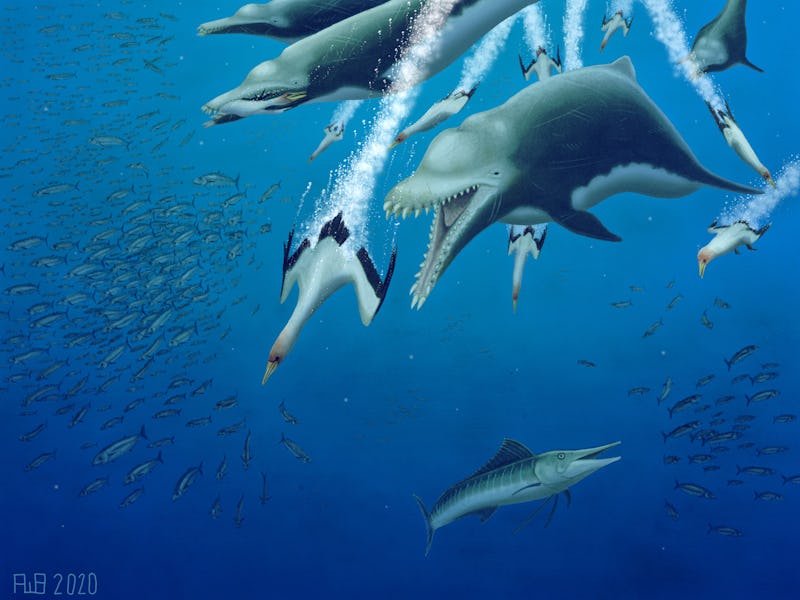15-foot-long skeleton reveals 23-million-year old apex predator
Researchers uncovered a complete, prehistoric dolphin skeleton.

More than 20 million years ago, the southern United States was home to a monstrous apex predator.
Researchers describe the full skeleton of a cetacean called Ankylorhiza tiedemani in a study published Thursday in the journal Current Biology. The 23-million-year-old bones indicate that a 15-foot-long dolphin with tusk-like front teeth once lived in present-day South Carolina. Its bones represent the first nearly complete skeleton of an extinct large dolphin.
The whale and dolphin ancestor dates back to the Oligocene and highlights an important step in the animals' evolution. Present-day cetaceans fall into two main categories:
- Toothed whales (odontocetes), which include dolphins, killer whales, porpoises, and narwhals
- Baleen (filter-feeding) whales, including right whale, blue whale, and gray whale
Lead study author Robert Boessenecker, a paleontologist at the College of Charleston, explains that before now, researchers believed that these two groups look similar today because they share ancestry — the idea being that a common ancestor would have a similar build. This skeleton throws a wrench in that theory.
The skull and skeleton of Ankylorhiza tiedemani.
"But Ankylorhiza, which is the first 'primitive' odontocete with a complete skeleton, lacks a number of features in modern cetaceans," Boessenecker tells Inverse. Previously, researchers had only discovered a partial snout from the animal.
This study is a new, robust analysis of the skeleton, which was found in the 1990s by a commercial paleontologist, unearthed during a housing construction project. The creature's tail, teeth, humerus bone, and finger bones tell a new story of evolution. The early-diverging dolphin had already split from other whales before it developed more modern traits.
That means that modern toothed and baleen whales evolved separately to have shorter, narrower bones, among other features.
Ancient marine predator — This is researchers' first look at the complete skeleton of one of Earth's earliest dolphins.
The large-headed dolphin had big teeth, with front teeth that stuck out like tusks — possibly to jab at prey — and an oversized forehead. A dome at the front of its head may have helped with echolocation.
Similar to a sperm whale, Ankylorhiza tiedemani "probably had somewhat stout pectoral fins," Boessenecker says, rather than the sleek fins of a faster swimmer.
Its teeth would have had thick roots and enamel ridges to cut through prey — a powerful image made even more striking because of its giant jaw muscles.
In ancient Charleston, the water was "teeming with life," Boessenecker says. Tuna, billfish, gannets, and "the world's most diverse assemblage of dugongs" all thrived in the area.
Ankylorhiza was well-adapted to eating its way through all that biodiversity. The fierce hunter wasn't as large as today's killer whales, but it was double the size of most other dolphins at the time, and likely occupied a similar niche in its ecosystem. It ate smaller dolphins, large fish, sea turtles, seabirds, and possibly larger cetaceans, too.
Between the biodiversity of Charleston and the Oligocene serving as the moment when traits like filter-feeding and echolocation first evolved, "the fossils from Charleston offer the most complete window into the early evolution of these groups," Boessenecker said — "offering unparalleled evolutionary insight."
Abstract: Modern whales and dolphins are superbly adapted for marine life, with tail flukes being a key innovation shared by all extant species. Some dolphins can exceed speeds of 50 km/h, a feat accomplished by thrusting the flukes while adjusting attack angle with their flippers [1]. These movements are driven by robust axial musculature anchored to a relatively rigid torso consisting of numerous short vertebrae, and controlled by hydrofoil-like flippers [2–7]. Eocene skeletons of whales illustrate the transition from semiaquatic to aquatic locomotion, including development of a fusiform body and reduction of hindlimbs [8–11], but the rarity of Oligocene whale skeletons [12, 13] has hampered efforts to understand the evolution of fluke-powered, but forelimb-controlled, locomotion. We report a nearly complete skeleton of the extinct large dolphin Ankylorhiza tiedemani comb. n. from the Oligocene of South Carolina, previously known only from a partial rostrum. Its forelimb is intermediate in morphology between stem cetaceans and extant taxa, whereas its axial skeleton displays incipient rigidity at the base of the tail with a flexible lumbar region. The position of Ankylorhiza near the base of the odontocete radiation implies that several postcranial specializations of extant cetaceans, including a shortened humerus, narrow peduncle, and loss of radial tuberosity, evolved convergently in odontocetes and mysticetes. Craniodental morphology, tooth wear, torso vertebral morphology, and body size all suggest that Ankylorhiza was a macrophagous predator that could swim relatively fast, indicating that it was one of the few extinct cetaceans to occupy a niche similar to that of killer whales.